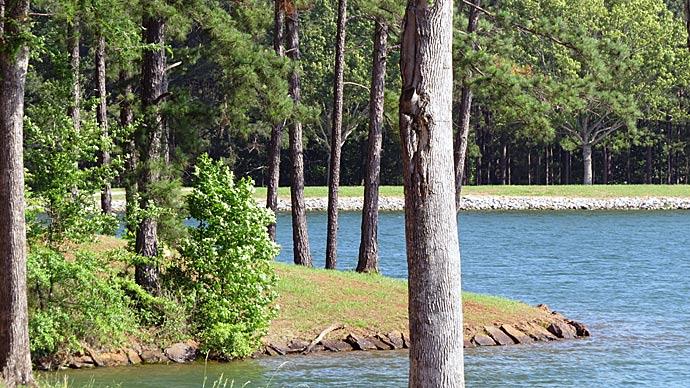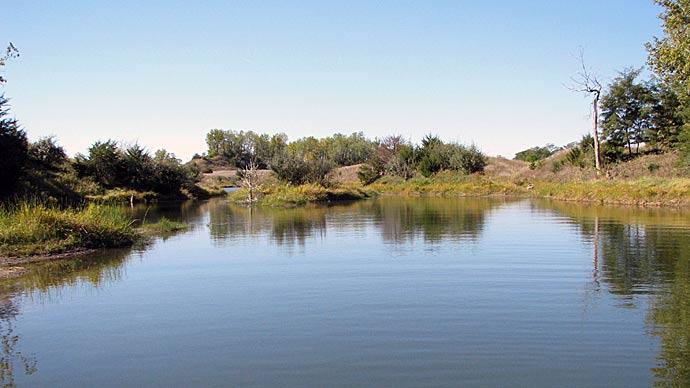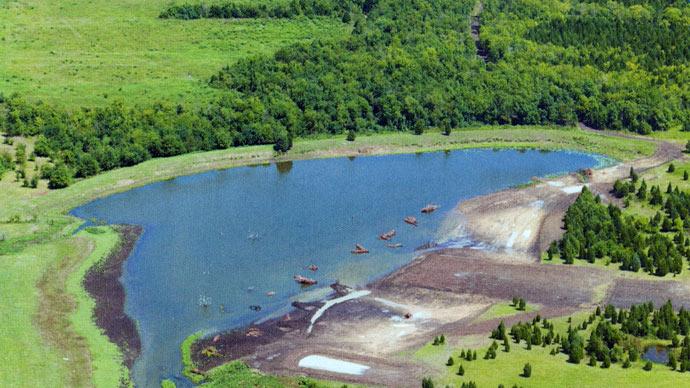Ask anyone, from structural engineer to bricklayer. How do you construct a building? From the bottom to the top, of course, and the answer seldom varies.
Same with a fishing pond. If you hope to raise giant largemouth, you begin by building the base of the food chain, using bluegill, fathead minnows, redear sunfish, maybe even crayfish, threadfin shad and other forage species. From this strong foundation, you work your way into aeration, fertilization, supplementary feeding, selective harvest and other management tools that, in time, will produce a big bass.
Ah, but look deeper, beyond the fish themselves. For hints of a pond's productivity and how accessible it might be, check the configuration and characteristics of the site itself.
Does the pond have a shallow perimeter, with a marshy upper end that turns into a mud flat by late summer? Is it a shallow bowl, with a main-lake basin as smooth as a cue ball?
If so, the site -- and the fish living there -- could use some attention.
Better, your site should have inlets, peninsulas, perhaps even an island or two. Below the surface, the bottom should have underwater humps, trenches and berms.
Indeed, most reservoirs could benefit from an aggressive fisheries consultant and a heavy piece of machinery in the hands of a skilled dirt contractor. Why?
Fish congregate and hold on these bottom features, often called "cover" or "structure." Lurking in or near these dropoffs and mounds, fish live out their lives, feeding, being fed upon, and spawning. With few exceptions, such as hatchery and aquaculture ponds, the more "personality' the pond shoreline and bottom has, the more fish it can support, with only minimal nudges from man.
Next time you visit your pond, view the site through the eyes of a fish and a fisherman.
Do the fish have places to hide? To ambush their prey? Places to spawn? Do the fingerlings have escape cover to elude the predators?
To a fisherman, the more irregular the shoreline and pond bottom, the better the fishing. He (or she) knows that bass, for instance, are "edge animals," that is, they lurk in the transition zones of distinctly different features such as a flooded creek channel next to a shallow flat.
It's not always necessary to hire a dozer operator and a consultant. Fact is, the aggressive pond manager can enhance his site by lashing tires together with bailing wire and sinking them with bricks. Piles of rocks or tree trunks make good holding areas for bluegill.
For both bass and bluegill, add spawning cover by placing on the bottom a number of plate-sized stones or cinder blocks to form the outline of a football. Within this perimeter, pour pea-sized gravel or road materials In the spring and early summer, bass and bluegill will use their tails to fan out shallow soup bowls in the gravel to lay their eggs.
In Texas waters, your field correspondent here has seen bluegill turn one of these manmade areas into a scene from the moon, with dozens of small craters attended by jealous spawning adults. Regardless of your geographic location, this cheap, easy spawning bed is likely to increase the recruitment rates of your pond.
For reasons known only to Mother Nature, bass tend to prefer objects that stand vertically in the water column. Trees, bridge pilings, manmade docks and piers all attract largemouth.
A private fishing club in South Carolina has a work day each year. Members bring in Christmas trees discarded after the holidays, and stick them in 5-gallon paint buckets. With the tree held in the upright position, members fill the buckets halfway with a sack of ready-mixed cement.
Once the cement hardens to concrete, the tree buckets are ready to haul out on the lake to be lowered to the bottom. The club lake has several pods or motts of tree buckets standing at various depths, from 3- to-8 feet.
At Firewheel Fishing Club, my group in Central Texas, we use Christmas trees all right, but also wooden shipping pallets. Shiners and other minnow-types will use the pallets to lay their eggs, says longtime fisheries consultant Malcolm Johnson, a member of the POND BOSS Field Advisory Staff.
All these projects may be tackled, with little or no expense, when water levels are normal. But several Texas pond owners thumbed their collective nose at drought this spring, and took advantage of low levels to recondition their pond sites.
Mark Smith, general manager of a car dealership in Dallas, for instance, retained POND BOSS to inspect his 20-acre lake site in San Saba County. The 40-year-old site, typical of those built in the 1950, '60s and '70s was constructed for the purpose of protecting against floods or watering livestock. Fishing was an afterthought.
After purchasing the property two years ago, Smith was eager to reverse the deterioration brought on by years of neglect. His goals were to add water storage capacity, and to bump up the fish production and the "fishability" of his site.
Simply put, he wanted a Lexus where his Chevy Cavalier once stood. I walked the entire site, jotting notes, taking "before" photos, visualizing what the lake could look like when it catches the six feet of runoff that will eventually come. As I saw it, my job was take an uninspired site and turn it into Disneyland.
Enter a young fellow named John Hughes. Unlike most dirt contractors, Hughes looks at a pond site and sees fish and fishermen. Most operators look at a site and see only how much dirt must be moved.
Removing silt from old creek channels? Fixing leaks? Creating new fish habitat? John Hughes lives for it.
"I take what dirt is there, and shape it into a fishing lake," Hughes said.
Using an excavator with a 60-foot boom for almost two weeks, Hughes and a sidekick cut trenches in the shoreline, deepened a feeder creek, diverted water from a low-lying marsh into another creek. To provide anglers with easy shoreline fishing, Hughes created walkways, spits and islands. The fish were not ignored either.
When the water level does get back to normal, nobody will be able to see the trenches Hughes cut next to the peninsulas, how he made it possible to stand on dry land and cast into 20 feet of water. Or how he made the feeder creek four feet deeper.
"Man! This thing will hold a lot more water now," Smith said, shaking his head when he first toured his site after the facelift. "Can you guys make it rain?"
Granted, this heavy renovation is a one-time project that may cost up to $1,500 a day, and not every pond owner has the commitment to excellence and that kind of financial quickdraw. Indeed, not everyone can fully appreciate what now looks like a bombing zone. Oh, but to a fisherman, and to a fish, it looks like home sweet home.
(For more information on John Hughes' pond design and renovation, phone 830-816-2548.)
| Know the law before your dig |
|
Many POND BOSS subscribers own rural property with pond dams built by the feds in the U.S. Army Corps of Engineers, or by a state agency. These lake sites are subject to strict government regulations, especially on storage capacity. Warning: Before you expand or deepen an existing impoundment, make sure you own it. Even then, dam construction and collecting surface water may be monitored by a flood control district or government conservation agency. Violators may be subject to steep fines. |
Reprinted with permission from Pond Boss Magazine



